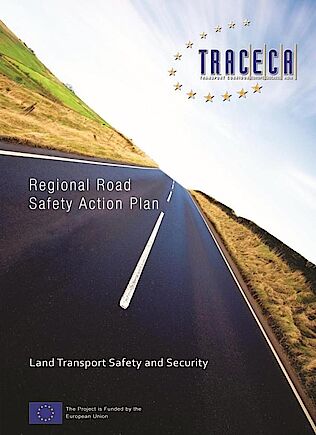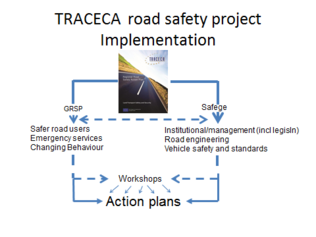TRACECA Road Safety II Project

TRACECA REGIONAL ROAD SAFETY PROJECTS
These projects are a follow up to an earlier EU funded regional road safety project that covered 9 countries in TRACECA region and which identified the areas of need in terms of road safety in each country and developed a generic regional road safety action plan[1] for the countries to uses as a model for developing their own country specific action plans. This regional road safety action plan was accepted and endorsed by all the beneficiary countries in 2011/2012 but despite several years having passed since this endorsement, none of the countries were able to develop their own country specific action plans as had been intended. Furthermore, Turkmenistan, a future potential TRACECA member, was not included in that original assessment or the regional action plan so needed to be brought into the action plan.
The earlier regional road safety action plan identified actions to be implemented in 6 sectors as follows:
1. Institutional issues
2. Safer roads
3. Safer vehicles
4. Safer road users / behaviour
5. Emergency medical services
6. Changing attitudes
The EU, in order to assist the TRACECA beneficiary countries, initiated further technical assistance to help the countries of the region in developing their individual country specific action plans (based on the regional action plan) and in implementing the improvements that had been identified in the regional action plan. For convenience, the downstream technical assistance was split so that sectors 1-3 were allocated to the Safege / IMC Consortia and sectors 4-6 were allocated to a GRSP led consortia. These two downstream Technical Assistance projects are to run in parallel and are both to be completed over the 2 years (Safege project Jan 2014 - Jan 2016 and GRSP project Mar 2014-Mar 2016) with each consortia providing advice and training through capacity building workshops, training courses and institutional development in their respective sectors.
Since road safety, because of the need for interaction between the sectors has to be implemented via a holistic approach, the two consortia have agreed to coordinate their efforts and to even provide inputs as needed into each other’s workshops so that a comprehensive multi sector approach is applied to improve road safety in each country. In particular, the action planning workshops to develop a holistic priority action plan for each country will involve inputs from experts from both consortia, with each being responsible for developing action plans and interventions for their sectors for inclusion in the country specific action plans. This will result in a single comprehensive country specific action plan in each country.
The Safege led road safety project

The EU-funded regional transport project: "TRACECA-Road safety II" will be undertaken over the 2 years Jan 2014 to Jan 2016 and will assist 10 beneficiary countries (Armenia, Azerbaijan, Georgia, Kazakhstan, Kyrgyzstan, Moldova, Tajikistan, Turkmenistan, Ukraine and Uzbekistan). Romania, Bulgaria and Turkey will be associated to the project as indirect beneficiary countries but will not be eligible for any technical assistance.
Overall objective
Implementation of the TRACECA Regional Road Safety Action Plan by assisting countries to strengthen institutional capacity and to develop and implement country specific road safety action plans to address their road safety problems. This will also ensure that the corridor transport system actively promotes the safety, security and protection of users, property, public and the environment that might be involved in or affected by this system.
Purposes
To complement the TRACECA-Regional Road Safety Action Plan with recommendations regarding Turkmenistan.
To support the beneficiary countries with the accession, ratification and implementation of the following EU agreements and UN Conventions:
- European Agreement concerning the international carriage of dangerous goods by road (ADR) (1957)
- Agreement concerning the adoption of uniform technical prescriptions for wheeled vehicles, equipment and parts, which can be fitted and/or be used on wheeled vehicles and the conditions for reciprocal recognition of approvals granted on the basis of these prescriptions (1958)
- Convention on Road Traffic (1968)
- Convention on Road Signs and Signals (1968)
- European Agreement concerning the work of crews of vehicles engaged in international road transport (AETR) (1970)
- European Agreement on main international traffic arteries (AGR) (1975)
- Agreement concerning the adoption of uniform conditions for periodical technical inspections of wheeled vehicles and the reciprocal recognition of such inspections (1997).
The Safege led project will support the beneficiary countries in developing and implementing programmes and interventions to improve road safety in a sustainable manner and envisages the following results grouped into 3 components.
Component 1: Inclusion of Turkmenistan
- Benchmarking of road safety activities in Turkmenistan in the same 6 sectors as used for the 9 TRACECA countries under the project
- Development of a country specific road safety action plan to enable Turkmenistan to implement the recommendations of the earlier regional road safety action plan
- Inclusion of Turkmenistan in all the capacity building activities being undertaken in other TRACECA countries
Component 2: Institutional issues
- Increased adoption of EU Agreements and UN Conventions related to transport safety
- Improved capacity of each country to manage, coordinate and finance road safety activities
- Improved data analyses and understanding of at risk road users groups and at risk behaviours so they can be targeted for safety interventions
- Better trained / informed personnel in the key stakeholders with interest in or responsibilities in road safety capable of developing and implementing effective road safety interventions
- Estimation of socio-economic impact of road crashes
Component 3: Safer road infrastructure and safer vehicles
- Review of standards and practices and assistance in activities and training to ensure safer road infrastructure.
- Review of standards and practices and assistance in activities and training to ensure safer vehicles.
The work is being implemented through a series of short regional, sub regional and country level workshops and seminars to train key personnel from each country and to assist them to develop country specific action plans. Project team experts will then do follow up visits to countries to do further training and to work with local experts to help resolve any problems they may be facing in implementing the road safety action plan. Monitoring of Implementation in all 6 sectors (including those to be done by GRSP) will be undertaken by the Safege led project team using specially derived “impact indicators“ which give assurance that developmental impact is occurring.
This project is being implemented by a consortium led by Safege (BE), and as partners IMC Worldwide Ltd (UK), Grant Thornton (Armenia) and Granturco (BE).
The project team leader is Alan Ross (e-mail: alanross999@gmail.com) and the Regional project coordinator is Mariya Ivchenko (e-mail: mariya.ivchenko@gmail.com).
The project office in Kiev is +38044 272 10 68, Tel/Fax +38044 331 02 17 and there are English, Russian and Ukrainian language speaking staff at the project office if further information is required.
Parallel GRSP led road safety project
It should be noted that a complementary regional EU-funded TRACECA project on Road Safety is being undertaken over the 2-year period (March 2014 – Feb 2016). This project envisages the following results, grouped in 3 components:
Component 1: Safer road users
• Increased road safety awareness among road users, especially vulnerable road users (children, elderly people, pedestrians, cyclists, motorcyclists);
• Enforcement capacity of the concerned authorities is increased, as shown by appropriate and consistent punishment of offenders.
Component 2: Medical care for crash victims
• Steps are taken to develop pre-hospital care systems and for dealing with crashes at the scene
• The needs for improved medical care for crash victims is outlined
• The “one call” emergency number system is developed and implemented
• Improving statistics on road traffic injuries
Component 3: Changing attitudes to road safety
• Civil society organisations are involved in road safety campaigns
• Road safety education is provided in schools on a systematic and continuous basis
• Driving training is improved.
It will be implemented by the Global Road Safety Partnership (GRSP), hosted by the International Red Cross.
(Contact person: Pieter Venter, E-mail: Pieter.venter@ifrc.org)
The EU Task manager for these 2 road safety projects is
Mr Stefaan Bil
Programme Manager – Transport & Integrated Border Management
DEVCO.F.3 – Regional Programmes Neighbourhood East
Tel + 322 299 37 63
Email: stefaan.bill@ec.europa.eu
[1] TRACECA regional road safety action plan, SAFEGE Consultants, Brussels, 2012





